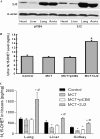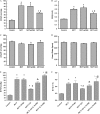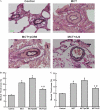Gene delivery of cytochrome p450 epoxygenase ameliorates monocrotaline-induced pulmonary artery hypertension in rats
- PMID: 20118222
- PMCID: PMC2993093
- DOI: 10.1165/rcmb.2009-0161OC
Gene delivery of cytochrome p450 epoxygenase ameliorates monocrotaline-induced pulmonary artery hypertension in rats
Abstract
Pulmonary arterial hypertension (PAH) is a life-threatening disease that leads to progressive pulmonary hypertension, right heart failure, and death. Endothelial dysfunction and inflammation were implicated in the pathogenesis of PAH. Epoxyeicosatrienoic acids (EETs), products of the cytochrome P450 epoxygenase metabolism of arachidonic acid, are potent vasodilators that possess anti-inflammatory and other protective properties in endothelial cells. We investigated whether gene delivery with the human cytochrome P450 epoxygenase 2J2 (CYP2J2) ameliorates monocrotaline (MCT)-induced pulmonary hypertension in rats. Significant pulmonary hypertension developed 3 weeks after the administration of MCT, but gene therapy with CYP2J2 significantly attenuated the development of pulmonary hypertension and pulmonary vascular remodeling, without causing changes in systemic arterial pressure or heart rate. These effects were associated with increased pulmonary endothelial NO synthase (eNOS) expression and its activity, inhibition of inflammation in the lungs, and transforming growth factor (TGF)-β/type II bone morphogenetic protein receptor (BMPRII)-drosophila mothers against decapentaplegic proteins (Smads) signaling. Collectively, these data suggest that gene therapy with CYP2J2 may have potential as a novel therapeutic approach to this progressive and oftentimes lethal disorder.
Figures







Similar articles
-
Endothelial nitric oxide synthase-enhancing G-protein coupled receptor antagonist inhibits pulmonary artery hypertension by endothelin-1-dependent and endothelin-1-independent pathways in a monocrotaline model.Kaohsiung J Med Sci. 2014 Jun;30(6):267-78. doi: 10.1016/j.kjms.2014.02.014. Epub 2014 Apr 30. Kaohsiung J Med Sci. 2014. PMID: 24835346 Free PMC article.
-
Angiotensin-converting enzyme inhibitor preserves p21 and endothelial nitric oxide synthase expression in monocrotaline-induced pulmonary arterial hypertension in rats.Circulation. 2001 Aug 21;104(8):945-50. doi: 10.1161/hc3401.093155. Circulation. 2001. PMID: 11514384
-
Targeted delivery of pulmonary arterial endothelial cells overexpressing interleukin-8 receptors attenuates monocrotaline-induced pulmonary vascular remodeling.Arterioscler Thromb Vasc Biol. 2014 Jul;34(7):1539-47. doi: 10.1161/ATVBAHA.114.303821. Epub 2014 May 1. Arterioscler Thromb Vasc Biol. 2014. PMID: 24790141 Free PMC article.
-
BMP type II receptor as a therapeutic target in pulmonary arterial hypertension.Cell Mol Life Sci. 2017 Aug;74(16):2979-2995. doi: 10.1007/s00018-017-2510-4. Epub 2017 Apr 26. Cell Mol Life Sci. 2017. PMID: 28447104 Free PMC article. Review.
-
Prostacyclin therapy for pulmonary arterial hypertension.Tex Heart Inst J. 2010;37(4):391-9. Tex Heart Inst J. 2010. PMID: 20844610 Free PMC article. Review.
Cited by
-
CYP2J2 overexpression increases EETs and protects against angiotensin II-induced abdominal aortic aneurysm in mice.J Lipid Res. 2013 May;54(5):1448-56. doi: 10.1194/jlr.M036533. Epub 2013 Feb 26. J Lipid Res. 2013. PMID: 23446230 Free PMC article.
-
CYP2J2 Molecular Recognition: A New Axis for Therapeutic Design.Pharmacol Ther. 2020 Nov;215:107601. doi: 10.1016/j.pharmthera.2020.107601. Epub 2020 Jun 11. Pharmacol Ther. 2020. PMID: 32534953 Free PMC article. Review.
-
Differential effect of amyloid β on the cytochrome P450 epoxygenase activity in rat brain.Neuroscience. 2011 Oct 27;194:241-9. doi: 10.1016/j.neuroscience.2011.07.058. Epub 2011 Jul 30. Neuroscience. 2011. PMID: 21843605 Free PMC article.
-
Vascular Lipidomic Profiling of Potential Endogenous Fatty Acid PPAR Ligands Reveals the Coronary Artery as Major Producer of CYP450-Derived Epoxy Fatty Acids.Cells. 2020 Apr 29;9(5):1096. doi: 10.3390/cells9051096. Cells. 2020. PMID: 32365470 Free PMC article.
-
Activated CD47 promotes pulmonary arterial hypertension through targeting caveolin-1.Cardiovasc Res. 2012 Mar 15;93(4):682-93. doi: 10.1093/cvr/cvr356. Epub 2012 Jan 2. Cardiovasc Res. 2012. PMID: 22215724 Free PMC article.
References
-
- Newman JH, Fanburg BL, Archer SL, Badesch DB, Barst RJ, Garcia JG, Kao PN, Knowles JA, Loyd JE, McGoon MD, et al. Pulmonary arterial hypertension: future directions: report of a National Heart, Lung and Blood Institute/Office of Rare Diseases workshop. Circulation 2004;109:2947–2952. - PubMed
-
- Itoh T, Nagaya N, Murakami S, Fujii T, Iwase T, Ishibashi-Ueda H, Yutani C, Yamagishi M, Kimura H, Kangawa K. C-type natriuretic peptide ameliorates monocrotaline-induced pulmonary hypertension in rats. Am J Respir Crit Care Med 2004;170:1204–1211. - PubMed
-
- Budhiraja R, Tuder RM, Hassoun PM. Endothelial dysfunction in pulmonary hypertension. Circulation 2004;109:159–165. - PubMed
-
- Ito T, Okada T, Miyashita H, Nomoto T, Nonaka-Sarukawa M, Uchibori R, Maeda Y, Urabe M, Mizukami H, Kume A, et al. Interleukin-10 expression mediated by an adeno-associated virus vector prevents monocrotaline-induced pulmonary arterial hypertension in rats. Circ Res 2007;101:734–741. - PubMed
Publication types
MeSH terms
Substances
LinkOut - more resources
Full Text Sources
Medical

